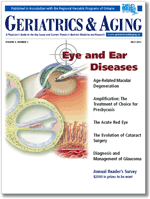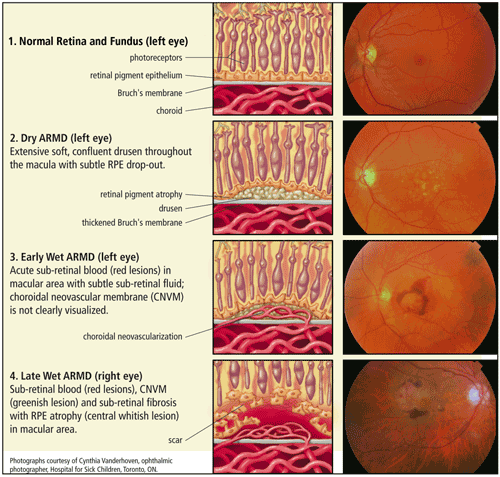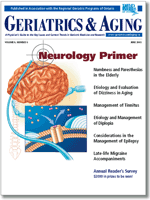 Classification of Age-Related Macular Degeneration vs. Age-Related Maculopathy
Classification of Age-Related Macular Degeneration vs. Age-Related Maculopathy
Dear Editor,
In the article "Age-Related Macular Degeneration: An Update on Nutritional Supplementation" (May 2003, Vol. 6, No. 5), the classification of macular degeneration stages may not be entirely accurate--at least it deviates from what is now accepted as standard classification in the major clinical trials. There is consensus that soft drusen represent age-related maculopathy, not macular degeneration. Geographic atrophy characterizes dry macular degeneration, while choroidal neovascular membranes and disciform scar characterize wet macular degeneration.
Sandeep Jain, MD
Instructor in Ophthalmology,
Harvard Medical School, Boston, MA, USA
Dr. Sohel Somani, author of the article "Age-Related Macular Degeneration: An Update on Nutritional Supplementation", responds:
I appreciate the opportunity to respond to Dr. Sandeep Jain's comments on the classification scheme of Age-Related Macular Degeneration (ARMD). While most would agree that geographic atrophy represents late dry ARMD, there is no clear consensus in the literature on how to classify drusen and retinal pigment epithelial changes. Some studies classify them as a mild to moderate dry macular degeneration, while others classify them as age-related maculopathy.
The classification scheme used in the Geriatrics & Aging article is similar to that used by The Age-Related Eye Disease Study Group (AREDS).1 Namely, this group classified ARMD into four levels depending on the type and extent of drusen, as well as the presence of geographic atrophy and neovascular changes. In this scheme, small soft drusen, in the absence of geographic atrophy, would be classified as Level 1 ARMD. In contrast, other studies would call these changes early age-related maculopathy.2
Hopefully, the differing terminology that may be encountered in various articles to describe early age-related macular pathology (i.e., degeneration vs. maculopathy) does not detract from the underlying point of the article; namely, to consider vitamin supplementation in those patients who meet the AREDS criteria.
Sohel Somani, MD
Medical Retina Fellow,
University of Toronto, Toronto, ON.

References
- The Age-Related Eye Disease Study Research Group. The Age-Related Eye Disease Study system for classifying age-related macular degeneration from stereoscopic color fundus photographs: the Age-Related Eye Disease Study Report Number 6. Am J Ophthalmol 2001;132:668-81.
- Bird AC, Bressler NM, Bressler SB, et al. An international classification and grading system for age-related maculopathy and age-related macular degeneration. Surv Ophthalmol 1995;39:367-74.
 Etiology of and Possible Therapies for Tinnitus
Etiology of and Possible Therapies for Tinnitus Dear Editor,
The article "The Management of Tinnitus" (June 2003, Vol. 6, No. 6) did not mention that one possible cause of tinnitus may be a vitamin B12 deficiency.1 Given that B12 deficiency is thought to affect up to 12% of older people,2 a therapeutic trial of vitamin B12 may be worthwhile even when the serum B12 level is not clearly subnormal, as more definitive tests of B12 deficiency, such as homocysteine or methylmalonic acid, are not always available.
Henry Olders, MD, FRCPC (Psychiatry),
Assistant Professor,
Faculty of Medicine, McGill University
Associate Psychiatrist,
SMBD-Jewish General Hospital, Montreal, QC.
References
- Shemesh Z, Attias J, Ornan M, et al. Vitamin B12 deficiency in patients with chronic-tinnitus and noise-induced hearing loss. Am J Otolaryngol 1993;14:94-9.
- Lindenbaum J, Rosenberg IH, Wilson PW, et al. Prevalence of cobalamin deficiency in the Framingham elderly population. Am J Clin Nutr 1994;60:2-11.
Dr. John P. Preece, co-author of the article "The Management of Tinnitus", provides the following response:
We thank Dr. Olders for bringing up the possible relation between vitamin B12 deficiency and tinnitus. Vitamin B12 deficiency has been implicated in a number of neurological deficits, including tinnitus.1,2 Since, as Dr. Olders notes, vitamin B12 deficiency is common in the older population, this link deserves further examination. Since none of us are physicians, we take no position on the value of a therapeutic trial with vitamin B12.
John P. Preece, PhD,
Associate Professor,
Communicative Disorders,
University of Rhode Island Kingston, RI, USA
Signed for co-authors R.S. Tyler, PhD and W. Noble, PhD
References
- Dharmarajan TS, Adiga GU, Norkus WP. Vitamin B12 deficiency. Recognizing subtle symptoms in older adults. Geriatrics 2003;58:30-4;37-8.
- Scherer K. Images in clinical medicine. Neurologic manifestations of vitamin B12 deficiency. N Engl J Med 2003;348:2208.
Dear Editor,
A host of electromagnetic stimulation therapies that goes back over 200 years was not mentioned in the article "The Management of Tinnitus" (June 2003, Vol. 6, No. 6). In recent years, cranio-electrical stimulation has proved successful in some types of tinnitus. Most recently, rTMS (repetitive transcranial magnetic stimulation), which has been very successful in drug-resistant depression, has shown potential. Admittedly, it is difficult to rule out a placebo effect and one has to be wary of spurious devices and extravagant claims. A thorough review of these techniques may be found in the forthcoming book Bioelectromagnetic Medicine, to be published by Marcel Dekker, Inc. later this year (http://www.dekker.com/servlet/product/productid/4700-3).
Paul J. Rosch, MD,
Clinical Professor of Medicine and Psychiatry,
New York Medical College, New York,
President of The American Institute of Stress,
Yonkers, NY, USA
Drs. Preece, Tyler and Noble reply:
The length constraints of the journal kept us from being truly comprehensive in our review of tinnitus. Dr. Rosch correctly reminds us that there have been many attempts at electromagnetic stimulation therapy over the years. We agree that rTMS appears to be a promising approach, at least for a subset of tinnitus sufferers. We look forward to the book that he mentioned. Plewnia, et al. have published a controlled clinical trial with 14 patients that showed significant results.1
John P. Preece, PhD
Richard S. Tyler, PhD,
Professor, Speech Pathology and
Audiology and Otolaryngology,
Head and Neck Surgery, University of Iowa, Iowa City, IA, USA
William Noble, PhD,
Professor, Psychology,
University of New England, NSW, Australia
Reference
- Plewnia C, Bartels M, Gerloff, C. Transient suppression of tinnitus by transcranial magnetic stimulation. Ann Neurol 2003;53:263-6.